Locavore Los Angeles
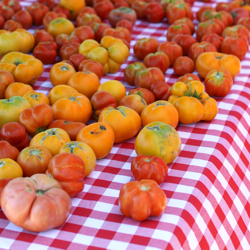 Once upon a time, Southern California was an agrarian epicenter where even small back yards usually boasted a mini-orchard, bursting with citrus or stone fruit.
Once upon a time, Southern California was an agrarian epicenter where even small back yards usually boasted a mini-orchard, bursting with citrus or stone fruit.
My father’s parents lived in semi-rural Monrovia, on a plot that included chickens, a kitchen garden, and a small avocado orchard that Dad tended to earn his allowance. Mom’s parents lived in suburban Glendale, but even their yard was full of edible options, including an enormous orange tree that we harvested for fresh-squeezed juice. As late as the 1980s, there were were actual citrus groves still supplying fruit for roadside stands near my childhood home in Orange.
But these days, urban blight and suburban sprawl have plowed under this once-fertile landscape; the names of streets and boulevards offer the last hint of the area’s pastoral past. Sadly, you’ll find no nuts on Nutwood, no oranges on Orangethorpe, no chiles in Anaheim. A few last pocket farms remain, but by and large they’re limited to mono-crops like strawberries or pumpkins… the kinds of u-pick items that scout troops and school groups will pay to see.
As you might imagine, an area this divorced from its farming heritage makes for a pretty tough locavore life. Despite a few large, well-regarded farmers markets, even the notion of a dedicated farm-to-table restaurant is pretty out on the fringe. LA Weekly–überfoodie Jonathan Gold laments that “the idea of locavore dining is more admired than actually practiced in Los Angeles, even at the restaurants where farmer-celebrities like Alex Weiser or the McGraths are treated with more awe than Matt Damon.”
For home cooks, local produce is widely available so long as your schedule and location make it easy for you to visit the bigger farmers markets in Irvine, Hollywood, or Santa Monica. But if you’re not able to shop on Saturday, you’re pretty much stuck with food of unknown origin. During our recent trip to the area, we rented a vacation house with my family for the week, and so we had access to a kitchen. But we got into town too late to hit the farmers markets… a mistake we will be sure not to repeat!
Much like the supermarkets back home in Northern California, none of those we visited in Los Angeles or Orange County offered any indication of where their food came from. Even Whole Foods was a joke: Items bottled in Napa Valley — at the other end of the state — were proudly labeled as “LOCAL!”. When we asked employees about this, they pointed out Whole Foods’ store policy: Anything raised within 7 hours of the market was considered local… perhaps the most liberal interpretation of locavorism that I can imagine. And although we’re used to having to pay close attention to sourcing even at our local Whole Foods, we were surprised that we didn’t see a single ‘local’ sign in the produce section.
But it was Henry’s Marketplace — part of the Wild Oats chain — that won the hypocrisy prize: A giant banner on the rear wall of the store read: “Choose LOCAL! Enjoy the freshest flavors from your community.” But in fact, the only local products we were able to find in the entire store were Broguiere’s milk (locally processed from semi-local, non-organic herds) and Henry’s own-brand eggs. Not a single fruit or vegetable bin was labeled with its point of origin, much less its farmer’s name.
 After much searching, we stumbled upon the website for South Coast Farms, one of Orange County’s last small-scale farm operations. We took a trek down Coast Highway to find that they do run a daily farm stand with a remarkably diverse set of offerings… our first clue that something wasn’t quite right. Turns out, only a handful of the items for sale are actually grown on site: Tomatoes, cucumbers, onions, and a few herbs. Others are ‘local’ — alas, no indication on signs of farms or even towns — and many are simply big-organic imports from South America. (Apparently, their CSA is a little more focused than the stand.)
After much searching, we stumbled upon the website for South Coast Farms, one of Orange County’s last small-scale farm operations. We took a trek down Coast Highway to find that they do run a daily farm stand with a remarkably diverse set of offerings… our first clue that something wasn’t quite right. Turns out, only a handful of the items for sale are actually grown on site: Tomatoes, cucumbers, onions, and a few herbs. Others are ‘local’ — alas, no indication on signs of farms or even towns — and many are simply big-organic imports from South America. (Apparently, their CSA is a little more focused than the stand.)
Working on a tip that Cal Poly Pomona offered local meat processed by their students, we took a trip out to the Farmstore at Kellogg Ranch. We did find local protein, but frozen chickens and a few sausages were all that the cases held. (Perhaps the stock is better during the school year?) Once again, it was anyone’s guess whether the fruits and veggies on offer were grown locally; there were a number of out-of-season crops for sale that made us suspect not. We got all excited over an entire wall of preserves, pickles, and sauces in quaint Mason jars, until we naively asked the store manager whether they were made by students, or just made from the farm’s own crops. “Oh, no…” she replied, with a tone that implied we’d just rolled off the turnip truck, “We just buy them from a company that puts our label on them.”
Defeated, we stopped into one of the smaller weekday farmers markets to see what we could cobble together. Although there couldn’t have been more than a dozen stalls, the mostly-Latino farmers offered a nice assortment of options: A basketful of tomatillos, a few heads of pungent celery, brown bags of fingerling potatoes, a huge pile of frying chiles, stacks of whiskery onions. Nobody seemed to be indulging in the luxury of specialization, which suited us just fine.
I won’t even go into the afternoon we spent trying to find local rolls for our sausages, but suffice to say we succeeded — even though we bought squishy commercial hoagie buns from the supermarket. A tiny corner store near our beach house supplied us with locally made tortilla chips, which we ate dipped in salsa verde made entirely from farmers market vegetables. For our entrees, we grilled up the German-style bratwurst we’d found at Cal Poly, topped them with a sauteed mix of peppers and onions, and served them on those supermarket buns. On the side, we had our favorite potato salad — everything locally sourced except the mayo and spices… and pickles from one of Kellogg Ranch’s faux-local canning jars.
Of course, it took us all week to get everything we needed, and our carbon footprint was enormous: We took the 100-Mile Diet to a literal extreme, racking up 90+ miles in the car on our search. I’m sure that with a little practice and a lot of hunting, we could find easier sources for much of what we drove around to find. But I’m thankful, more than ever, for the bounty that sits literally at my doorstep in San Francisco.
South Coast Farms
32701 Alipaz Street
San Juan Capistrano, CA 92675
(949) 661-9381
Monday through Saturday 9am to 5pm; Sundays 9am to 4pm
The Farmstore at Kellogg Ranch
4102 S. University Drive
Pomona, CA 91768
(909) 869-4906
Sunday through Friday 10am to 6pm; Saturday 8am to 6pm
Tustin Farmers Market
Corner of El Camino Real and 3rd Street
Tuesdays, 9am to 1pm
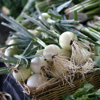
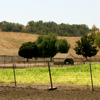
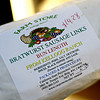
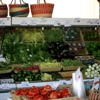
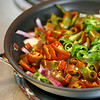




Comment by j gold
Locavore eating in Los Angeles needn’t be as grim as all that, especially for someone as dedicated to sourcing ingredients as you are. The Wednesday Santa Monica market and Sunday Hollywood market are the glamorous ones, but there are fine small farmers markets every day of the week, most of which have at least one local meat or poultry purveyor, plus another specializing in local seafood in addition to a fine array of produce. Brandt Beef is local, and its sustainable meat is both delicious – it’s what Thomas Keller uses – and readily obtainable at supermarkets like How’s. There are many good bakeries in town, and a great mill that has been operating downtown for more than 100 years. A lot of us do still have fruit trees and gardens in our yards. And for the ultimate in locavore eating, you can always consult the maps at http://www.fallenfruit.org/maps.html and consume surplus urban fruit right off the tree.
Posted on 08.05.08 at 3:32AM
Comment by Kim
Phew! I’m hungry and tired just reading about your search. I think a lot of people will be surprised to learn about how “un-local” Southern California actually is. I was floored by the lack of local produce when visiting my parents in the Temecula area. Those of us who had over 100″ of snow this winter and still enjoyed local eating want to grab SoCal’s shoulders and give ’em a good shake!
Posted on 08.05.08 at 7:15AM
Comment by Alice Q. Foodie
I know what you mean. When I wetn to Irvine in the late 80s/early 90s, there were still lettuce fields where the Irvine Spectrum now stands. Still, I wouldn’t say Southern Cal is especially “un-local” in comparison to anywhere else. San Diego County has the greatest concentration of small farms in the U.S., and we still have to go to farmers markets, farm stands, or People’s Organic Foods to get the goods. Much of it goes to restaurants, in Los Angeles as a matter of fact.
Didn’t know Keller uses Brandt Beef. We have access to it through a wholesaler, and it’s sold at our local farmers markets, but it’s pretty expensive. About $20./lb for steak, (a little less for bavettes which are what we get) burger patties retail for $7. apiece!
Posted on 08.05.08 at 8:43AM
Comment by Adrianna
I accidentally stumbled upon a glorious restaurant in So Cal that’s a beautiful rendition of farm to table dining. Next time you’re down south try Omakase in Riverside.
http://www.restaurantomakase.com/
They source most of their menu from a local garden, it changes with whatever is in season so there’s always something new to try!
Posted on 08.05.08 at 8:53AM
Comment by sam
I had similar (if less) difficulties when I tried the Eat Local Challenge in Bristol, England, last year. Most of the problem was that I didn’t know where to find the local stuff because I didn’t live there and had only done a small amount of research (in comparison to the amount of time I dedicate to finding out similar facts in the Bay Area where I live, for example). Thankfully Bristol is a lot smaller than LA and we were able to find venison, for example, shot by the farmer himself on an Estate just 20 miles away. Had I been more ensconced in the local community, like j gold, instead of being a visitor, things would have been easier.
Are there not any bloggers in LA getting these kinds messages out? (I know we have a plethora of them in the Bay Area). In Bristol I couldn’t find a single food blogging soul.
Posted on 08.05.08 at 9:00AM
Comment by cookiecrumb
Arghh! So frustrating. Congratulations on your limited success. (Kinda fun, though, wasn’t it?)
Posted on 08.05.08 at 10:10AM
Comment by Jennifer Jeffrey
This is kind of like a grown-up version of “Where’s Waldo?” – only the striped-shirted one has been replaced with local food.
Fun to a degree, but rather sad too, when you consider that most people simply won’t put that degree of effort in. Nor should they have to – get on your game, SoCal!
So glad you blogged about it – more stories like this might stimulate the locavore movement down south.
Posted on 08.05.08 at 10:16AM
Comment by RebeccaC
I admire your committment but am exhausted just hearing about it!
Posted on 08.06.08 at 8:15AM
Comment by Nate
We in Northern California don’t know how good we’ve got it!
Posted on 08.06.08 at 9:54AM
Comment by Eugenia
Good sleuthing! At one point, I was going to make a “rape the land” salad with all the crops that used to grow in Orange (oranges, avocado, almonds, etc.) but never got around to it.
To j gold above, I’d argue that The OC is much more difficult than LA. I was fortunate enough to live next to the Irvine farmer’s market, which really does have lovely veggies, especially Asian ones, but I’d rely on the Persian market down the road (Wholesome Choice) for vegetables that were worth eating the rest of the week. Meat, who knows? Dairy, heck no. Other stuff? Not so much.
Posted on 08.06.08 at 3:38PM
Comment by Will
You guys in the Bay Area really are spoiled. My sister lives in San Francisco and I couldn’t believe it when she showed me the Ferry Building Market. All I can say is wow! A whole store dedicated completely to mushrooms?
Us foodies down here have to work a little harder, but we still get the job done. I live in Long Beach and do most of my shopping at the Alamitos Bay Farmer’s Market on Saturdays. Though maybe only 25% of the produce is certified organic, most is grown without pesticides. We always have fresh seafood, free-range eggs, and grass fed bison available, and sometimes we get rarities like local chicken and mangoes. The mangoes I found last year came from a farm near the Salton Sea and were some of the most delicious I’ve ever tasted. Sunset did an interesting write up about them which you can read here: http://www.sunset.com/sunset/travel/article/0,20633,1643134,00.html.
I also found a great source for local sour cherries which I will do a write-up about soon.
Posted on 08.06.08 at 4:46PM
Comment by Post
A divine post!
Posted on 08.07.08 at 10:02AM
Comment by Joan
Last year I tried to find a way to buy a CSA share for my son for a birthday present (at his request)and found the options surprisingly limited for North Hollywood. Since he doesn’t own a car, he couldn’t travel too far to pick it up. But, I was just so surprised given my assumptions about the climate, etc. We have many more (and less expensive) options in Portland. Ultimately, he has found a couple of farmer’s markets within a reasonable distance that he is enjoying. So, I have an appreciation of the difficulties you were having.
Posted on 08.07.08 at 10:29PM
Comment by Green Bean
I grew up in Southern California. This post sure resonated with me. Some of my family still lives there and have made a few valiant but unsuccessful efforts to eat local. I always assumed it would be available out there. Guess I’m lucky I moved 7 miles north.
Posted on 08.10.08 at 8:10PM
Comment by Kat
I am originally from Tustin and I used to shop at that farmer’s market all the time, and still do on breaks from school. I’d like to point out, even if this is an older article, that the market is on Wednesdays.
Posted on 03.12.09 at 11:54AM
Comment by stuffed
With a little work and local knowledge even in OC one can do well as a locavore. As for South Coast Farms, they should be commended for struggling mightily against major odds. As you noted, their CSA is more “focused.” All of the ‘duce at their farmstand is organic and most of the year the majority comes from local farms.
For local meat in south OC-north SD
try http://www.homegrownmeats.com/
Posted on 03.14.09 at 8:34PM